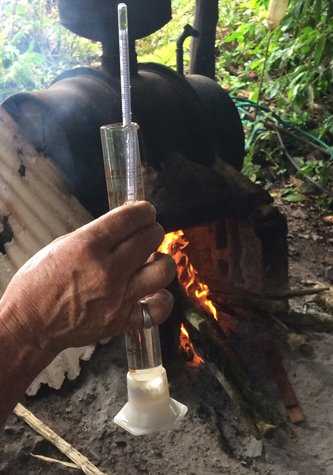As we pulled into Academy Bay, named when the California Academy of Sciences came to the islands in 1905, there were already a few folks on the top deck limbering up with our Wellness Specialist in preparation for the day ahead. It was a relatively early start in an attempt to avoid the pending heat and humidity, which we did very well it turns out. Of course a bit of cloud cover didn’t hurt either.
At the Galapagos National Park Giant Tortoise breeding center, the little ones were out and about, testing their abilities to cross rough terrain. This is a skill they will need to know when they finally return to their home islands in a few years. The big giants were happy because today is when the food would be coming around, and that is always something to look forward to. If this program hadn’t been initiated by the National Park with the expertise of the Charles Darwin Research Station personnel, researchers and scientists, many of our giant tortoises would be on the brink of extinction by now. Fortunately, today we can say they are doing much, much better…some sub-species thought gone, are even in business again, producing eggs! It is still a long road ahead, but we are well on our way with this iconic species for the islands and the world.
Through town one never knows quite what to expect. Shoppers got to shop and people-watchers got to see life on an island on the equator in the Pacific. We also got to watch the exciting show which included the two-winged, two-legged, four-flippered and four-legged, who were found at the fisherman’s wharf checking out this morning’s catch.
The southeastern corner of the island of Santa Cruz has high humidity, so there is a lot of lush vegetation, even down into the arid zone. That’s possibly one reason the tree-form of Galapagos prickly pear cactus is exceptionally tall here, making it the tallest in the archipelago and therefore the tallest in the world. “Opuntia gigantea” is indeed massive and impressive. The genus Opuntia varies greatly from island to island and during this expedition we get to see forms sturdy and wide, tall and slender, and one with spines soft enough to pet (on Genovesa).
By the time we had finished lunch up in the highland restaurant “Narwhale”, we had tried the local cane products at the Trapiche, wandered the gardens of the restaurant, seen cacao trees in flower, achiote (“poor man’s saffron”), bananas on the stem (and tried them sun-sweetened and ripe), eaten roasted coffee beans with cane sugar, tried cane molasses with cheese, eaten delicious chicken and vegetables, and had chocolate cake with toasted coconut topping washed down with local black coffee and lemongrass tea.
The feast didn’t slow anyone down! After lunch the trip continued even higher into the highlands where giant tortoises from Santa Cruz, the longest residents by millennia, wandered through private property and national parkland following their instincts for food and reproductive activity. By great fortune the clouds stayed with us, yet didn’t rain on us. A lava tube would have provided protection and did from the still-warm temperatures. Deep inside the tube things are cool and dark and this short section of lava tube was a new experience for many folks. We entered the emptied tube left behind when a river of molten lava cooled around the edges and flowed out down-slope.
Back onboard hot showers and cool air-conditioning beckoned to all. Music and dancing after dinner was a final highlight before crashing into bed!







